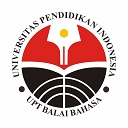MODEL LISTEN READ DISCUSS (LRD) DALAM PEMBELAJARAN DOKKAI
Abstract
Abstrak
Penelitian ini bertujuan untuk mendeskripsikan keefektifan penggunaan model Listen Read Discuss (LRD) dalam pembelajaran dokkai pada mahasiswa tingat I Departemen pendidikan bahasa Jepang. Jenis penelitian ini yaitu penelitian kuantitatif eksperimen murni dengan desain penelitian Pretest posttest control group design. Dalam penelitian ini, penulis menggunakan dua kelas yaitu kelas eksperimen yang menggunakan model Listen Read Discuss (LRD) dan kelas kontrol yang menggunakan model Think-Pair-Share (TPS). Populasi dalam penelitian ini adalah keseluruhan mahasiswa tingkat I Departemen Pendidikan Bahasa Jepang FPBS UPI. Teknik pengambilan sample dilakukan dengan Random Sampling yang diperoleh kelas C sebagai kelas eksperimen dan kelas B sebagai kelas kontrol. Data diperoleh dari pretest, post-test, dan angket. Hasil analisis menunjukkan nilai t hitung lebih besar dibandingkan nilai t tabel (t hitung ≥ t tabel) yaitu 5,30 ≥ 2,71 pada taraf signifikansi 5% dan 1%. Dengan ini dapat disimpulkan bahwa model pembelajaran Listen Read Discuss (LRD) efektif digunakan dalam pembelajaran dokkai.
Kata Kunci : Listen Read Discuss (LRD), Dokkai, Membaca.
Abtract
The aims of the research are to describe the effectiveness of using Listen Read Discuss (LRD) model in dokkai learning on the first grade students of Department Japan educations FPBS UPI. This research is the kind of pure experimenting research with using Pretest posttest control group design. In this research, researcher using two class of experiments. First was experiment class that using Listen Read Discuss (LRD). Second was control class that using of Think-Pair-Share (TPS). The population of this reseach is the whole first grade students of Department Japan educations FPBS UPI. The technique of the sample is done with using Random Sampling which are obtained class C as experimenting class and class B as controlled class. The data are obtained by pretest and posttest with essay and true-fault test forms with the result value, t hitung more high then t tabel (t hitung ≥ t tabel) namely 5,30 ≥ 2,71 on the 5% and 1% signifikansi level. In reality, it can be concluded that Listen Read Discuss (LRD) model can be used in dokkai learning effectively.
Keyword : Listen Read Discuss (LRD), Reading Comprehensive, Reading
Full Text:
PDFReferences
Sudijono. Anas 2001. Pengantar Statistik Pendidikan. Jakarta: PT Raja
Grafindo.
Sugiyono. (2011). Metode Penelitian Kualitatif Kuantitatif dan R&D.
Bandung: Alfabeta.
Sutedi, Dedi. 2011. Penelitian Pendidikan Bahasa Jepang. Bandung:
Humaniora.
DOI: https://doi.org/10.17509/japanedu.v1i1.2653
Refbacks
- There are currently no refbacks.
Copyright (c) 2016 JAPANEDU: Jurnal Pendidikan dan Pengajaran Bahasa Jepang

This work is licensed under a Creative Commons Attribution-ShareAlike 4.0 International License.
 Published by:
Published by: Department of Japanese Language Education, Faculty of Language and Literature Education
Universitas Pendidikan Indonesia
 Online ISSN: Online ISSN:2528-5548 |

JAPANEDU: Jurnal Pendidikan dan Pengajaran Bahasa Jepang (e-ISSN:2528-5548) lisenced under a Creative Commons Attribution-ShareAlike 4.0 Internasional (CC BY-SA 4.0)


